Menus
- Two-stroke missiles
- Also a pleasure on patched asphalt
- Adler was already whistling from the last hole
- Adler MB 250 with delicate 16-inch wheels
- First of all, brake on refusal to work
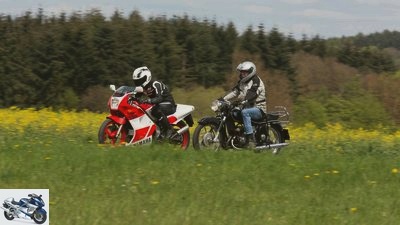
Volker Rost



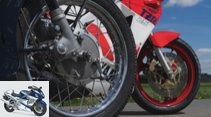
14th photos
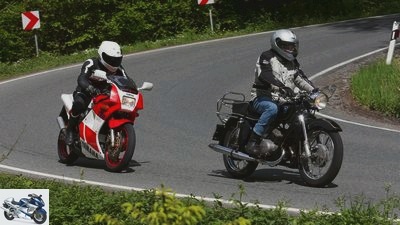
Volker Rost
1/14
Two-stroke rockets Yamaha TZR 250 and Adler MB 250.
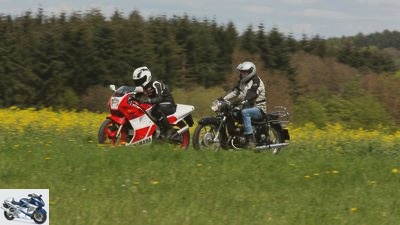
Volker Rost
2/14
Two-stroke rockets Yamaha TZR 250 and Adler MB 250.
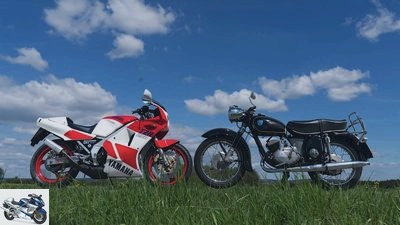
Volker Rost
3/14
Two-stroke rockets Yamaha TZR 250 and Adler MB 250.
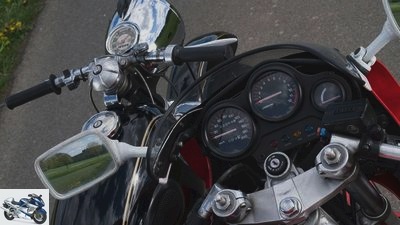
Volker Rost
4/14
Two-stroke rockets Yamaha TZR 250 and Adler MB 250.
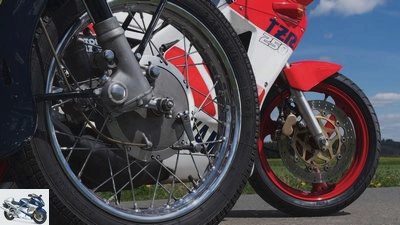
Volker Rost
5/14
Two-stroke rockets Yamaha TZR 250 and Adler MB 250.
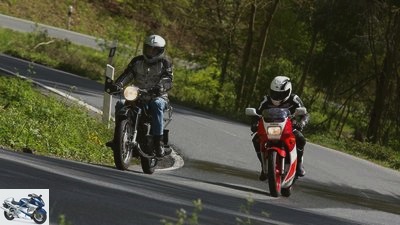
Volker Rost
6/14
Two-stroke rockets Yamaha TZR 250 and Adler MB 250.
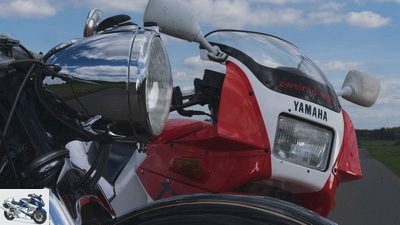
Volker Rost
7/14
Two-stroke rockets Yamaha TZR 250 and Adler MB 250.

Volker Rost
8/14
Two-stroke rockets Yamaha TZR 250 and Adler MB 250.

Volker Rost
9/14
Two-stroke rockets Yamaha TZR 250 and Adler MB 250.
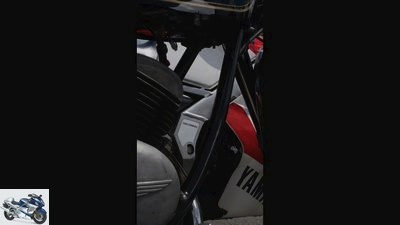
Volker Rost
10/14
Two-stroke rockets Yamaha TZR 250 and Adler MB 250.
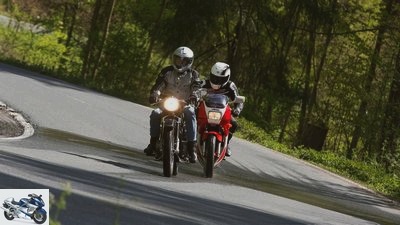
Volker Rost
11/14
Two-stroke rockets Yamaha TZR 250 and Adler MB 250.
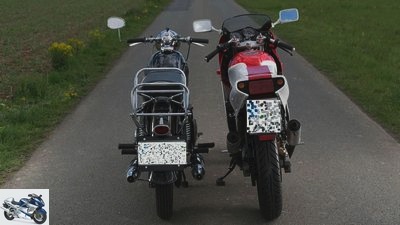
Volker Rost
12/14
Two-stroke rockets Yamaha TZR 250 and Adler MB 250.
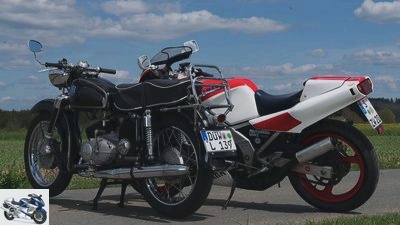
Volker Rost
13/14
Two-stroke rockets Yamaha TZR 250 and Adler MB 250.

Volker Rost
14/14
Two-stroke rockets Yamaha TZR 250 and Adler MB 250.
Yamaha TZR 250 and Adler MB 250
Two-stroke missiles
Content of
30 years ago, the TZR 250 ignited the last two-stroke rocket from Yamaha. Hard to believe: 30 years earlier, the Adler MB 250 Sprinter was considered the sportiest of this guild.
There was a rift through the MOTORRAD editorial team: While some colleagues were collecting topics for the first issues of the CLASSIC offshoot in 1987, others saw technical nirvana approaching. Here everything revolved around Brough Superior, DKW or at most Munch, there you watched breathlessly as Nippon’s sons threw around innovations after heavyweight standard goods had dragged them into an initial sales crisis in the early 1980s. The second in the industry Yamaha often took on the leading role, but – much to the delight of a sworn editorial clique – also remained true to its roots. The two-stroke, which is why a four-cylinder Rambo called RD 500, presented in 1984, was followed three years later by the much more sensitive Yamaha TZR 250.
Buy complete article
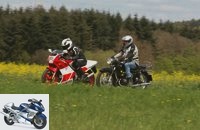
Yamaha TZR 250 and Adler MB 250
Two-stroke missiles
Yamaha TZR 250 looks almost like new
Two cylinders in line, as usual with Yamaha’s quarter liters. But! With fiberglass membrane inlet directly into the crankcase, with power valve control of the exhaust duct, with flat slide carburetors, with 50 approved PS. 50, yes, developed at 10,000 revolutions of the 180-degree crankshaft. This hitherto unique bundle of energy is suspended in a delta box, which is open at the bottom and made of light metal profiles that connect the forged steering head directly to the swing arm bearings. The aluminum rear swing arm is deflected by a central spring strut, a 39 millimeter fork guides the front wheel, inside which a floating 320 mm disc with a four-piston fixed caliper brakes. Last but not least, hollow-cast three-spoke light-alloy wheels demonstrate the efforts to make lightweight construction, in the end it is 150 kilos. With a full tank, of course.
The Stuttgart Yamaha dealer Edgar Walz, known as a two-stroke junkie, gave his 87 Yamaha TZR 250 for a short lap and therefore did not fill up with a full tank. So 140 kilos. Breathtaking. And if you didn’t know that two-stroke is taboo today and that all headlights are now pointing somehow crookedly into the area, you could consider them new, no, because of small battle marks on the muffler and engine cover for a young used one. And it was really only yesterday that you were dragged into the underground car park by your colleague Mini Koch in order to pay tribute to this marvel. The start-up procedure is just as familiar: flip the choke lever, kick it twice without gas and ignition, then turn on the ignition, kick it, let it start without gas, after a few seconds carefully increase the speed.
Also a pleasure on patched asphalt
How wonderfully Yamaha has created an integrated yet comfortable seating position on this small motorcycle, even for taller people. How easy it is to use. How well the engine can sputter through the community in the fourth. Up to the exit sign. Down in the third, let it pull up to a good 8,000. The twin does this very homogeneously, benefiting from the fact that the electric motor-controlled roller valves in its outlet duct shorten the control times at low speeds. Only above 7,000 rpm do they release the entire cross-section, then the Yamaha TZR 250 can play racers, and that’s what it is with its proximity to the Production Racer TZ. The needle of the cooling water thermometer is in the green area…
Fully up-to-date in effect, the mighty disc brakes the motorcycle before a tight bend. Second course, over 7,000 tours. One turn, and the Yamaha TZR 250 clicks forward, upshifts at over 10,000, slows down slightly and then quickly into a combo of curves, flip over like nothing, stay on the gas, upshift again and out. Also a pleasure on patched asphalt, fed by absolutely sovereign stability and wheel guidance. Yes, even out of comfort, because the spring elements, which are perhaps a little too soft for use on the racetrack, are all the more suitable for country road sports with their sensitive response and great absorption capacity. So again. And again.
Adler was already whistling from the last hole
And then back, because the next two-stroke sports car is already waiting in the garage of Adler’s friend Erich Bock. An Adler MB 250, presented in 1956, therefore another 30 years older than the Yamaha TZR 250. “30, so what?”, One would like to ask about the intoxication on the “old” Yamaha, but the sight of this darling shows that 30 Years can go by faster or slower. They have to be racing, from 57 to 87. VDO standard speedometer in a huge lamp housing, above the ignition nail with Bakelite handle. Bench cushions like a sofa, knee cushions on the tank, sweeping mudguards, carburetors with hoods over them. One almost thinks to hear the eagle’s rolling TZR, not without compassion, responding: “Grandma, you look old.”
After all, the youngtimer recognizes the family relationship. Before Yamaha’s engineers launched their first quarter-liter twin in 1956, they had taken a close look at Adler’s, the engine of their YD-1 looks damned like the Frankfurt school. But while the Japanese were just getting started back then, Adler was already whistling from the last hole due to the German motorcycle crisis, the racing department closed and new developments canceled. In 1956 a new frame with a rear swing arm had to be bent with great effort. That was really overdue, because the fixed Adler MB 250 had always appealed to particularly ambitious drivers since its debut, at best very fast NSU Maxes could keep up.
Adler MB 250 with delicate 16-inch wheels
But let’s start from the beginning: While others were looking for their salvation in the sale of rock-solid, but also well-behaved Westerwald motorcycles with tough single-cylinder, the motorcycle returnee Adler brought a parallel twin in the M 200, which was built from 1951. A subtle, even sensitive one, because apart from its compact clutch on the left crankshaft stump (like Yamaha’s YD-1, who would have thought?) And the alternator mounted opposite, it only has low flywheels. Helical-toothed spur gears – and not the chain that was widespread at the time – took over the primary drive to the four-speed transmission. The market immediately demanded a larger engine, in 1952 the M 250 appeared, thanks to the larger bore it brought it to 247 cm³. The 180 degree crankshaft rotating in three ball bearings is threaded into two parts into the one-piece engine housing and then connected by means of a Hirth serration. A central carburetor feeds both cylinders, producing 16 hp. Not enough to market Adler’s great sporting successes. So there was also a sports model whose engine produced 18 hp at 6,200 rpm thanks to enlarged ducts and lighter two-ring instead of three-ring pistons.
Adler gave a lot of thought to a low overall center of gravity, which is why not only does the engine lean forward within the double-loop frame, which is why the Adler MB 250 also has delicate 16-inch wheels. As was common in the early 1950s, the rear wheel only has straight-travel suspension, while at the front a very idiosyncratic, pushed short swing arm with coil-band suspension takes care of the wheel guidance. That was only dampened by friction, but no sooner did the economic miracle unfold, and such pre-war stuff was no longer enough. So in 1954 a short swing fork with internal spring / damper elements was created, and from now on it was called MB instead of M. Two years later the swing arm frame finally came, and that brings us to the everlasting Adler top model, the MB 250 Sprinter in Erich’s garage. It has it, and it even has 18-inch wheels – for aesthetic reasons, so that not so many people would buy NSU Max.
First of all, brake on refusal to work
Dab it briefly, kick it twice, and the engine comes on. And sounds really modern. Sings the song of praise of the engine speed, no comparison with a 250 DKW or Zundapp, after a short time hangs attentively on the gas. “The first is at the top, idling at the very bottom”, Erich removes any remaining uncertainties, and a journey of discovery into the early modern era begins. It’s extremely handy around the Brunnchen on the corner, and you’ll be sure of your goal. The sitting position behind the narrow handlebars is almost modern – it prompted MOTORRAD tester Paul Simsa to make the remark, which is still fondly copied today, that this is where you sit in a motorcycle, which cannot be said of the BMW R 26 and NSU Max. Perhaps, in any case, this posture arouses sporting appetites, and therefore the already known test track is targeted. The five-speed gearbox must have been invented on the way there, because in the third the eagle yells on a loooong slope that Erich shouldn’t hear it, and in the fourth she gasps for breath and mercy. By the way, Ernst “Klacks” Leverkus, the most famous of all MOTORRAD testers at the time, confessed that he kept turning the tap off: After initial problems with clamps, the Adler twins were damned robust.
What is not to be checked here, even without shouting, the pace is enough for the wonderful combination of curves with the tight bend at the beginning. The brakes – you need both! – Initially act on refusal to work, if the effort is higher, the front remains there and the rear threatens to block. Made it, down to the second, as usual. After that, yes, the third one fits, but so straight, when you fold down the spongy seat reduces your feeling for the motorcycle, the front fork prances on the patched asphalt and the shock absorbers teeter at the rear. The gas path is getting long and longer, but of no use: again no connection in the fourth. But now, because now it’s going downhill. The swing arm is mounted in silent blocks. Do you notice that? The old people praised the chassis so much. In any case, something is twisting down there, and now you would like to compare it with a Max and not always think of the Yamaha TZR 250. Because you want to believe it and somehow you have known for a long time that the Adler MB 250 was techno too. Only now, on this curvy slope, does it seem like a German hit.
Related articles
-
Bilski 13 pictures Bilski 1/13 An almost 40 year old Yamaha XT 500 that looks fresh from the store, a day with a steel blue sky, sun until …
-
32 photos 1/32 2/32 3/32 Only limit the incline buttons on the footrests – but they wear out over…
-
archive Impression Yamaha FZ 750 Tractor Damn it, at least when it comes to miracles, time should pass a little less. More respectful. Or more gracious….
-
10 photos Jorg Kunstle 1/10 Cult again today: the small, lockable utensil box at the rear under the delicate one Luggage rack only had the…
-
On the move: the Honda VF 500 F II and Yamaha RD 500 LC
fact On the move: Honda VF 500 F II and Yamaha RD 500 LC Extreme athlete Content of At the beginning of 1984, the Honda VF 500 F II and Yamaha RD 500 LC…
-
Kawasaki KH 400, Yamaha DT 400, Yamaha RD 400
bilski-fotografie.de 27 photos bilski-fotografie.de 1/27 In the well-stocked, clear RD cockpit, there are all the necessary warning lamps, including an…
-
Impression: Yamaha HL 500 Time Machine MOTORRAD editor Gert Thole, 46, dared a journey into his own past: almost 25 years after his racing debut, he…
-
Karsten Schwers 47 photos Yamaha 1/47 After the first driving impressions in May 2018, we had the opportunity to try out the new Yamaha Niken again in…
-
Innovations Yamaha Vmax model 2009
Yamaha Innovations Yamaha Vmax model 2009 New Yamaha Vmax Summer slump? Are you kidding me? Are you serious when you say that. The surprising and…
-
Comparison test Honda NT 650 V Deauville versus Yamaha XJ 600 S
Comparison test Honda NT 650 V Deauville versus Yamaha XJ 600 S Time of awakening Tried and tested against a new mix – the Yamaha XJ 600 S has seen a…